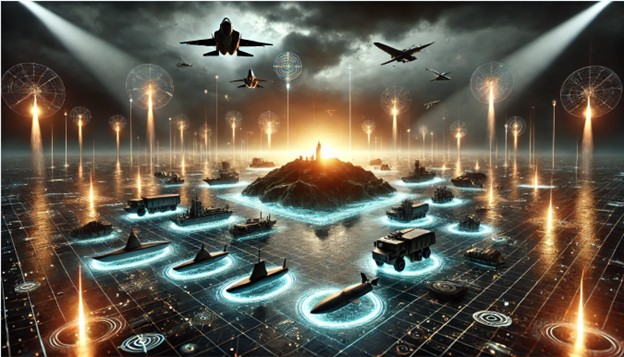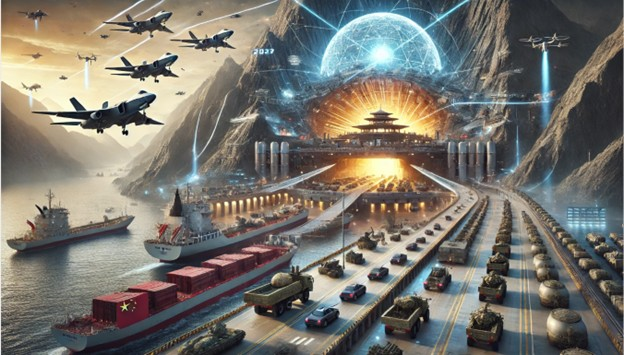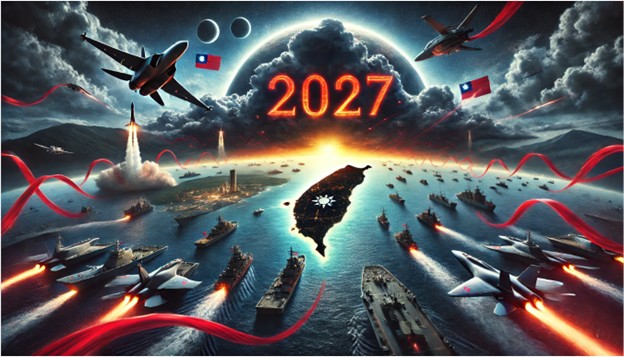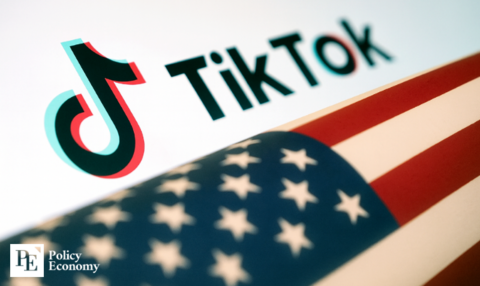The Taiwan Flashpoint and China's Military Rise: The Countdown to 2027
Input
Modified
Pressure, Escalations, and Exercises Preparing for the Unimaginable Stormy Seas Ahead

Pressure, Escalations, and Exercises
For years, 2027 has hovered over U.S. defense circles like an accumulating storm cloud. In honor of Admiral Phil Davidson, the former chief of U.S. Indo-Pacific Command, the "Davidson Window" is named after the year in which he cautioned that China may be prepared to forcibly reunify with Taiwan. The symbolic significance of the date has increased with each passing year, despite the fact that Beijing has never officially confirmed it. The 100th anniversary of the People's Liberation Army (PLA) is marked by this event, which also coincides with the anticipated commencement of Xi Jinping's unprecedented fourth term and the upcoming presidential election season in Taiwan. This is a juncture that is both historically and politically significant.
However, U.S. officials have gradually altered their perspective. 2027 is now regarded as the year by which Xi intends to finalize the material preparations necessary for potential significant combat operations, rather than a hard deadline for invasion. However, this reframement does little to alleviate apprehensions, particularly in light of the alarming progress that China has made in numerous domains of warfare, as indicated by recent intelligence and satellite imagery.
What was previously perceived as a theoretical timeline is rapidly becoming a tangible reality. China is in the process of constructing a military machine that can challenge U.S. power in the Western Pacific and alter the status quo across the Taiwan Strait. This involves the development of advanced stealth aircraft, satellite constellations, new amphibious assault capabilities, and enormous underground command centers.
China initiated a series of extensive military exercises that encircled Taiwan in early April 2025, which significantly escalated those concerns. The exercises, which were codenamed "Strait Thunder-2025A," included blockade simulations utilizing warships, aircraft carriers, and rocket forces, as well as precision strikes in the East China Sea. It was the most concentrated demonstration of Chinese military power since the "Joint Sword-2024B" exercises in October of last year.
76 Chinese warplanes, 15 naval vessels, and four coast guard ships were deployed near the island in a mere 24 hours, according to Taiwan's Ministry of Defense. In addition, China conducted joint operations to the east and west of Taiwan, with the objective of simulating energy facilities and ports. The Eastern Theater Command's footage depicted the launch of missile artillery systems under the cover of night, which Beijing characterized as a "stern warning" to "Taiwan independence separatist forces."
A speech by Taiwanese President Lai Ching-te, who referred to China as a "foreign hostile force" and proposed a package of 17 measures to counter Chinese infiltration and espionage, appeared to be the immediate catalyst. The following were implemented: the restoration of military tribunals for espionage cases and the augmentation of surveillance measures for mainland visitors. Beijing responded with vitriolic rhetoric, depicting Lai as a parasite in propaganda videos and accusing him of contaminating Taiwan with separatism.
Analysts, however, contend that the exercises exceed mere political signaling. They function as both realistic rehearsals for future conflict and psychological warfare. The PLA is intentionally practicing blockade tactics, joint force operations, and amphibious assaults. Despite Beijing's assertion that it is committed to peaceful reunification, its military posture is increasingly indicative of its readiness for conflict.
Nevertheless, Taiwan's daily existence remains largely unaffected by the intensity of China's display of force. The most recent exercises were perceived as routine by the residents of Taipei, which is indicative of the extent to which military pressure has become normalized. "The local populace will not be overly alarmed by this," stated a resident. However, the implications are significant for defense planners and regional analysts.

Preparing for the Unimaginable
A more profound transformation is concealed beneath the surface of China's highly visible maneuvers. The People's Liberation Army (PLA) is currently engaged in a vigorous modernization initiative that is designed to eliminate the technological and operational deficiencies that would impede an invasion of Taiwan or a military conflict with the United States.
Western defense analysts have recently identified novel mobile bridge vessel designs that are capable of allowing China's extensive civilian fleet—which includes roll-on/roll-off ferries and container ships—to land tanks and heavy equipment along Taiwan's coastline. Filling a critical void in China's amphibious capabilities could be achieved through the mass production of these vessels.
In the interim, China has nearly tripled its arsenal of precision ballistic and cruise missiles to approximately 3,500 since 2020 and has doubled its missile launchers to 1,500. This significantly enhances the PLA's capacity to strike U.S. bases throughout the Western Pacific, including Guam, in a single salvo.
Additionally, infrastructure is being renovated. The upgrading of dozens of airfields within striking distance of Taiwan is underway, with the installation of reinforced aircraft shelters, additional taxiways, and extended runways. Preparation for the intricate logistics of amphibious warfare is indicated by an increase in military coordination with commercial vessels. The J-36 and the J-XX/J-50, two new stealth fighter-bombers, were unveiled by China in December. These aircraft are intended for precision assaults and long-range anti-aircraft operations. Although these aircraft will not be operational by 2027, their rapid advancements serve as a testament to China's technological advancements.
The construction of a substantial subterranean command center during wartime, located near Beijing, is perhaps the most striking. The facility, which is constructed into a mountainside with reinforced concrete that extends over 100 meters into the ground, spans 1,500 acres and indicates China's commitment to maintaining command and control capabilities in the event of a full-scale conflict.
Nevertheless, substantial voids persist. The PLA has not yet conducted a comprehensive, integrated exercise that would involve all military branches, including the Coast Guard and civilian assets, as would be necessary in a genuine amphibious invasion. China has not conducted any tests on mass civilian mobilization or simulated combat operations from civilian infrastructure, which are essential components of its "all-of-regime" warfare doctrine.
Furthermore, the PLA has made progress in the development of platforms and missile capability; however, it continues to encounter obstacles in its pursuit of dominance in the three domains that China considers to be essential: air, sea, and information. Maintaining and establishing superiority in a hostile electromagnetic environment, while simultaneously disrupting adversary communications and ensuring the continuity of PLA command, is a constant work in progress.
However, as analysts caution, the rapidity and breadth of China's advancements necessitate that we anticipate unexpected developments. The final years of China's 14th Five-Year Plan and the early days of its 15th may reveal new systems, tactics, and strategies that blur the line between peacetime drills and actual war preparations.

Stormy Seas Ahead
The Biden administration previously dismissed 2027 as an overly speculative timeline for a significant conflict; however, the Trump administration has adopted a significantly different perspective. Secretary of Defense Pete Hegseth recently visited Tokyo, where he reaffirmed the United States' commitment to Taiwan and pledged to provide robust deterrence in the Indo-Pacific. The Pentagon has been directed to prioritize readiness in order to thwart a potential Chinese attempt to seize the island.
In the interim, China is treading a precarious path. It postponed its most recent exercises until after a significant investment summit in Beijing, despite its desire to demonstrate its strength. This delay, according to analysts, is indicative of a strategic balancing act: the attempt to demonstrate military strength without alarming foreign investors. However, the maintenance of this delicate equilibrium is becoming increasingly challenging as tensions escalate.
Beijing's readiness to reduce tensions across the Taiwan Strait is evidently diminishing. Analysts at Eurasia Group warn that the likelihood of a "cross-strait crisis" is increasing in 2025. China is inching closer to transforming the Davidson Window from a prediction to a perilous reality with each new satellite launch, stealth fighter deployment, or island-encirclement exercise.
The forthcoming months will be of paramount importance. The PLA is advancing on all fronts, U.S. allies in the region are observing nervously, and Taiwan's defense posture is hardening. The determination of whether 2027 will be a false alarm or a conflagration may be contingent upon miscalculations rather than intentions, as well as whether the world acknowledges the proximity of the storm clouds.





















